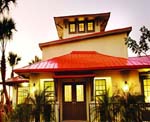
Sarasota architect Michael Carlson designed the 2009 HGTV Green Home in Port St. Lucie, Fla.
Home-Grown Green
Green. Eco-friendly. Florida friendly. LEED certified. Whatever the term you use, the biggest trend in green building is the very fact that it's grown from a trendy idea to mainstream application.
As technology advances, the opportunities and availability of affordable options are multiplying. And while official designations exist for the ultimate in green building, LEED (Leadership for Energy and Environmental Design) certification, homeowners shouldn't be intimidated into thinking they can't benefit from green technology. �
"People think there's a silver bullet to tackle energy, but really you just need somebody who can help sort through and identify the opportunities," says Steve Ellis of MyGreenBuildings in Sarasota.
Picking and choosing the right products and services can help you save money on utilities, create a healthier atmosphere indoors and provide more comfort. After all, a recirculating hot water system not only saves water that would otherwise run down the drain, it also delivers hot water for your shower on demand, not while you wait shivering at 7 a.m. ��
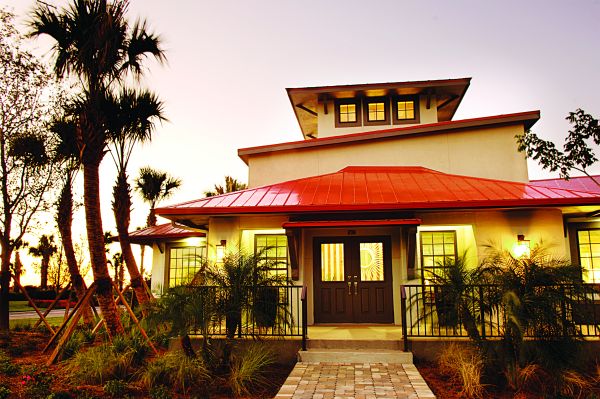
At the high end is LEED certification. Architect Michael Carlson, vice president of the U.S. Green Building Council Florida Gulfcoast Chapter - and designer of the 2009 HGTV Green Home built in Port St. Lucie that was featured nationally on-air last spring to an audience of millions - notes that certification is a complicated process that covers whole-house building, from heating and cooling to landscaping, recycled materials and healthy indoor air quality. The comprehensive program works best with new construction because, says Carlson, "If you think about it from the beginning you can have all those ideas in your head and it's pretty easy to incorporate in advance."
But it's not a matter of all or nothing. Although builder John Cannon of John Cannon Homes meets the strict requirements as a LEED-certified builder, he emphasizes that it's not necessary for the typical homeowner to go through LEED certification to reap benefits. "Green certified and LEED are two separate designations, but going through the process of LEED certification gives a builder the advantage of understanding what it takes to then apply those techniques," he says. ����
That fact increases the green potential for all homes, new or renovated. And that brings us to the area of biggest growth in green construction: remodeling.
Turning an Existing Home Green
"We think of green construction as new construction," says Michael Carlson. "But remodelers are driving the green wave of the future." Cost savings, of course, drive the trend, but so does the fact that there's simply not as much new construction happening in residential construction.
Even an existing home can generate savings from energy-efficient appliances and air conditioning. According to Ellis of MyGreenBuildings, "If your air conditioner is more than seven years old, buy new, because the money spent will be saved in energy costs." Make sure your house has good insulation in the roof, walls and windows. Caulking helps eliminate air leakage, and it could be worthwhile to have a professional check your home by pressurizing it in order to uncover the location of air leaks. The smart use of fans, window shading, even landscape shading cut cooling costs. �
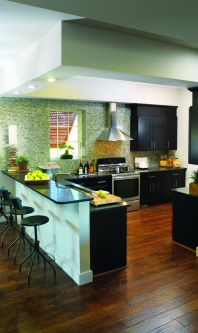 �
�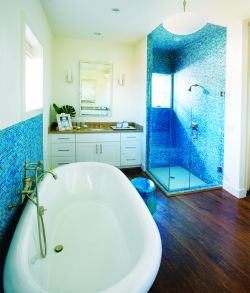
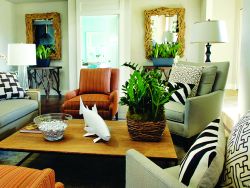 �
�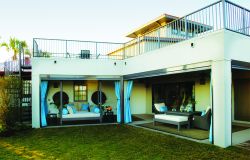
It may not be possible to add more sophisticated hot water systems to an existing home, but contemporary low-flow faucets and dual flush toilets also lower water costs.
Insulating attic spaces makes a big difference, adds Ellis. "Trying to air condition your home and running the A/C ducts designed for cold air through a hot humid environment is counterproductive."
One solution that Andrew Tanner of Eco Technologies recommends is new BioBased spray foam. The polyurethane foam can be sprayed to walls or under the roof, where it expands to fill the nooks and crannies for a thermal seal so that the air-conditioning ducts in the attic don't have to fight extra heat. Soy-based and a renewable resource, BioBased foam can reduce heating and air conditioning costs by 30 percent to 50 percent over traditional insulations.
Expanding Solar Energy Options
Solar or photovoltaic energy converts sunlight into electricity. It's clean energy and can supply enough power to cut electric bills or even take a homeowner off the power grid. Setting up a system is even more affordable with government incentives. Solar can heat the home, provide electric to power appliances and heat the water.
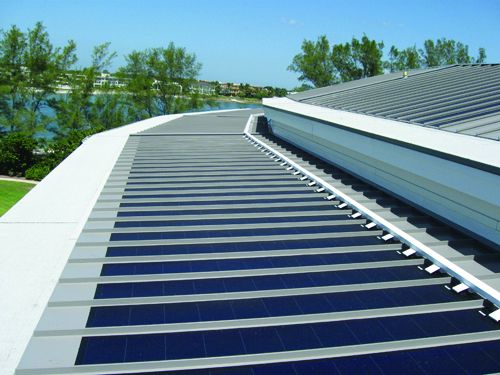 We're accustomed to seeing large solar panels on roofs. However, Eco Technologies also offers an innovative solution in the form of solar adhesives. The thin, flexible product sticks to the roof surface without penetrating it with bolts as do traditional solar panels. That's a big plus, says Tanner, because it lessens the potential for leaks and withstands Florida's strong sun, downpours and tropical winds. It's the only photovoltaic product that's rated Miami Dade for wind testing 150 mph winds.
We're accustomed to seeing large solar panels on roofs. However, Eco Technologies also offers an innovative solution in the form of solar adhesives. The thin, flexible product sticks to the roof surface without penetrating it with bolts as do traditional solar panels. That's a big plus, says Tanner, because it lessens the potential for leaks and withstands Florida's strong sun, downpours and tropical winds. It's the only photovoltaic product that's rated Miami Dade for wind testing 150 mph winds.
Another option is enphase micro inverters. Until recently, solar panels used a central micro inverter to transform energy to power, but the enphase version sits behind each solar panel for direct conversion. "It's versatile because you can go from one panel to as many panels as you like without having to fit into the inverter system," says Tanner. "If you want more power on another roof line, you can just add panel by panel."
Plus, solar hot water is a major benefit for those intending to stay in their homes for several years, says Ellis. "A solar hot water heater is an expensive installation of about $3,000, but offers a very high return with free hot water for the rest of your days."
Collecting Water and Conserving It
Water conservation is a major issue everywhere, and that's especially true in Florida. A pioneer technology from olden days has been modernized with advanced rainwater collection systems that capture and treat rain for use in the landscape and home.
"The homeowner can use the water for washing clothes and the car, and plants love it more than municipal water," says Skip VerMilyea, president of Raindrops Cisterns. "Not only are we saving water, but it's an emergency fresh-water source. A lot of clients use the rainwater for gardening, but with a filtration block, it's potable for drinking. And in dry season or during a power outage the system will shift back to municipal water, so the house is never without water."
Greening Up, Naturally
Landscaping adds green literally as well as financially. On the list of trends, landscape contractor Trent Culleny Sr. ranks low-volume irrigation systems No. 1. Drip irrigation sends water directly to the root zone to avoid the evaporation loss of spraying. Replacing turf grass with native vegetation that is suitable for the soil and climate requires less water and fertilizer. And shading the home with trees, especially over west-facing windows, is an efficient and cost-effective way to reduce heat gain.
Healthier Recycled Materials
Recycled materials and those from renewable resources such as cork or bamboo flooring are both beautiful and practical. Countertops made from recycled materials now offer the sophisticated look, feel and high performance of marble and granite but, unlike granite, are less damaging to the earth. One such product is ECO by Cosentino, made of 75 percent recycled content composed of porcelain, glass, mirror or stone scraps and bound by an environmentally friendly resin that comes in part from corn oil. Products with low VOC (volatile organic compounds) improve indoor air quality by limiting the use of formaldehyde and other compounds often found in everything from carpets to cabinets to paints, sealants and adhesives.
Services Help You Manage the Options �
If you're really confused by all the options, new services are sprouting up designed to help homeowners evaluate the countless choices available. A new Sarasota company called DwellGreen, which co-founder Steve Ellis sees as a natural offshoot of his own MyGreenBuildings, is such a service. A DwellGreen representative will inspect your home and suggest eco-friendly improvements. �"The opportunities are there, but they're also interrelated, so someone has to figure out the priorities and cost benefit of each," says Ellis. "Solar is hot, but the homeowner might not need as much in the way of panels if they also reduce the demand in the home."
In another example, he notes that simply replacing the air-conditioning unit but leaving the old windows may not change the equation much and provide the savings or comfort desired. But performing other improvements, such as adding insulation or replacing windows with insulated ones on the home's west walls, may enable the homeowner to get a different, smaller air-conditioning system and improve the overall savings while keeping the home comfortable.
Much of the solution is simply knowing a solution exists. As John Cannon says, "It really doesn't cost any extra to build a home to green standards. It's just taking the time to make sure the guiding principles are followed."
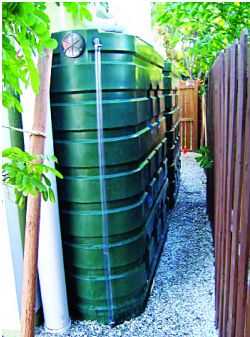 Get Paid for Making Green Upgrades.
Get Paid for Making Green Upgrades.
Act now and you may be able to piggyback on a variety of federal, state and utility incentives that can make energy-efficient improvements more affordable.
Those costly solar electric or hot water systems could earn you as much as 30 percent of the cost back. Certain energy-saving appliances and other products may also be eligible for a federal tax credit under the American Recovery & Reinvestment Act of 2009. Plus, many local utility providers offer rebates to increase the percentage of energy coming from renewable sources in their grid.
For more information on tax credits, rebates and eligible products, visit the U.S. Environmental Protection Agency Web site at energystar.gov. Or consult your tax advisor.
